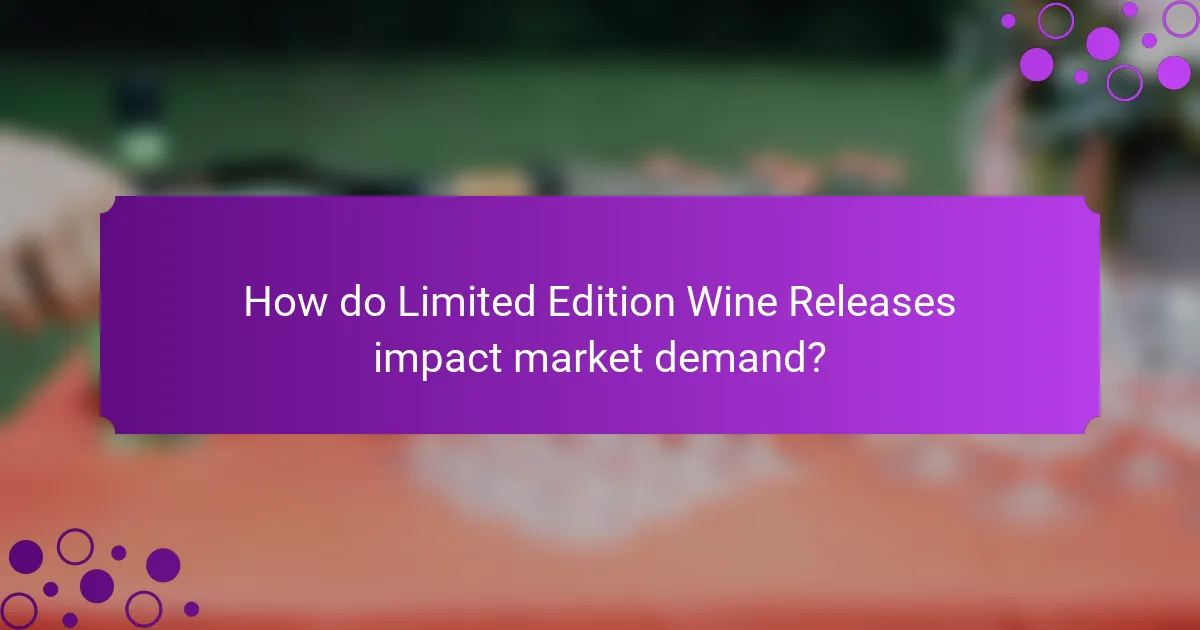
What are Limited Edition Wine Releases?
Limited Edition Wine Releases are unique, specially produced wines offered in limited quantities. These wines often feature distinctive characteristics, such as specific grape varieties or unique aging processes. Wineries create these releases to highlight exceptional quality or commemorate special events.
The exclusivity of limited edition wines typically drives higher demand among collectors and enthusiasts. For example, a winery may produce only a few hundred bottles of a particular vintage. This scarcity can significantly increase the wine’s market value over time.
Limited edition releases often attract attention through marketing campaigns and tasting events. As a result, they can create a buzz in the wine community, influencing consumer behavior and pricing trends.
How do Limited Edition Wine Releases differ from regular wine releases?
Limited Edition Wine Releases differ from regular wine releases in exclusivity and production volume. Limited editions are produced in smaller quantities, often creating scarcity. This scarcity can drive higher demand and prices. Regular wine releases typically have larger production runs and are more widely available. Limited editions often feature unique blends or aging processes that are not found in regular offerings. They may also come with special packaging or labeling. These factors contribute to their appeal among collectors and enthusiasts. The limited nature can enhance perceived value, making them sought after in the market.
What characteristics define a Limited Edition Wine Release?
A Limited Edition Wine Release is characterized by its exclusivity and finite availability. These wines are typically produced in small quantities, often less than a few hundred cases. They may feature unique blends or single vineyard selections that are not available in regular production. Limited Edition wines often come with distinctive packaging or labeling that highlights their special status. They are frequently released to commemorate a specific event or milestone in the winery’s history. The marketing strategy for these wines emphasizes rarity, appealing to collectors and connoisseurs. This exclusivity can drive higher market demand and increase pricing, as consumers are willing to pay a premium for unique offerings.
Why are Limited Edition Wine Releases produced?
Limited Edition Wine Releases are produced to create exclusivity and enhance brand prestige. This strategy attracts collectors and connoisseurs willing to pay a premium. Limited editions often feature unique blends or rare grape varieties. They can drive demand through scarcity, increasing perceived value. Additionally, these releases allow wineries to showcase their craftsmanship and innovation. Historical evidence shows that limited releases often sell out quickly, indicating strong market interest. For instance, a 2019 study found that limited edition wines commanded prices up to 50% higher than standard offerings. This approach not only boosts sales but also strengthens customer loyalty.
What is the significance of Limited Edition Wine Releases in the market?
Limited Edition Wine Releases hold significant value in the market due to their exclusivity and rarity. These wines often attract collectors and enthusiasts who seek unique offerings. The limited availability creates a sense of urgency, driving demand. Such releases can lead to increased prices, sometimes exceeding standard market values. For instance, according to a study by Liv-ex, limited edition wines can appreciate by over 30% within the first year of release. This trend highlights the investment potential of these wines. Additionally, they enhance brand prestige and consumer loyalty. Overall, Limited Edition Wine Releases play a crucial role in shaping market dynamics and consumer behavior.
How do Limited Edition Wine Releases affect consumer perceptions?
Limited edition wine releases significantly enhance consumer perceptions. These releases create a sense of exclusivity and rarity. Consumers often associate limited editions with higher quality. This perception is driven by the unique attributes of the wines. Limited editions typically feature special packaging or unique blends. They are often marketed as collectible items. Research shows that scarcity can increase demand and willingness to pay. A study by the Journal of Consumer Research indicates that consumers perceive limited availability as a signal of higher value.
What role do Limited Edition Wine Releases play in brand differentiation?
Limited Edition Wine Releases serve a critical role in brand differentiation. They create a unique identity for a winery in a crowded market. These releases often feature exclusive blends or packaging, appealing to collectors and enthusiasts. This exclusivity enhances perceived value and desirability. According to a study by the Wine Market Council, limited editions can increase consumer interest and willingness to pay. Additionally, they foster brand loyalty among customers who seek unique experiences. By offering something distinctive, wineries can stand out from competitors. This strategy ultimately drives sales and strengthens brand positioning.

How do Limited Edition Wine Releases impact market demand?
Limited edition wine releases significantly increase market demand. These releases create a sense of exclusivity and urgency among consumers. Limited availability often drives collectors and enthusiasts to purchase quickly. According to a study by the Journal of Wine Economics, scarcity enhances perceived value. This perception leads to higher prices and increased consumer interest. Historical data shows that limited releases often sell out within days. The rarity factor also encourages secondary market trading, further fueling demand. Overall, limited edition wines effectively stimulate market activity and pricing dynamics.
What factors influence the demand for Limited Edition Wine Releases?
The demand for Limited Edition Wine Releases is influenced by scarcity, brand reputation, and consumer trends. Scarcity creates a sense of urgency, making consumers more likely to purchase. Limited releases often signify high quality, enhancing brand reputation. Additionally, consumer trends toward exclusivity and unique experiences drive demand. Research shows that limited edition products can see a sales increase of up to 30% compared to regular offerings. The combination of these factors results in heightened interest and willingness to pay among consumers.
How does scarcity affect consumer desire for Limited Edition Wines?
Scarcity significantly enhances consumer desire for Limited Edition Wines. Limited availability creates a sense of urgency among consumers. This urgency leads to increased perceived value. Research shows that consumers often associate rarity with higher quality. A study published in the Journal of Consumer Research found that limited editions trigger emotional responses. These responses drive consumers to purchase more quickly. Additionally, scarcity can lead to competitive behavior among buyers. This competition further elevates demand and prices.
What demographic trends are associated with Limited Edition Wine purchases?
Demographic trends associated with Limited Edition Wine purchases include higher income levels and age factors. Consumers with disposable income are more likely to invest in premium wines. Additionally, individuals aged 30 to 50 are the primary purchasers of limited editions. This age group often seeks unique experiences and exclusivity. Furthermore, wine collectors and enthusiasts drive demand for these products. Studies show that 60% of limited edition buyers are male, indicating a gender trend. Geographic location also plays a role; urban areas exhibit higher purchase rates. These trends suggest a targeted marketing approach for limited edition wines.
How do Limited Edition Wine Releases create a sense of urgency among consumers?
Limited edition wine releases create a sense of urgency among consumers by emphasizing scarcity. Scarcity triggers a fear of missing out, prompting quicker purchasing decisions. Limited availability often leads to increased demand. Consumers perceive these wines as exclusive and unique. This exclusivity enhances their desirability. Marketing strategies often highlight the limited nature of these releases. For example, phrases like “only 500 bottles available” are common. Such tactics effectively motivate consumers to act swiftly to secure their purchase.
What marketing strategies are used to promote Limited Edition Wines?
Limited edition wines are promoted through exclusive marketing strategies. These strategies include targeted social media campaigns that create buzz among wine enthusiasts. Influencer partnerships amplify reach and credibility, showcasing the unique qualities of the wines. Limited-time offers create urgency, encouraging immediate purchases. Events such as tastings and launch parties enhance consumer engagement and experience. Email marketing campaigns inform subscribers about upcoming releases and special promotions. Collaborations with luxury brands elevate the perceived value of the wine. These strategies effectively drive demand and influence pricing in the competitive wine market.
How do events and tastings influence demand for Limited Edition Wines?
Events and tastings significantly increase demand for limited edition wines. These activities create exclusive experiences that attract wine enthusiasts. They provide opportunities for consumers to sample unique offerings. This direct engagement fosters emotional connections with the brand. Events also generate buzz through social media and word-of-mouth. According to a study by the Wine Market Council, 72% of wine consumers are influenced by tasting events. Furthermore, limited availability heightens the perceived value of these wines. This combination of factors drives higher sales and consumer interest.

What is the impact of Limited Edition Wine Releases on pricing?
Limited edition wine releases typically lead to higher pricing. This is due to their scarcity and perceived exclusivity. When a winery produces a limited edition, it creates a sense of urgency among consumers. This urgency often drives demand, allowing wineries to set premium prices. According to a study by the University of California, Davis, limited editions can command prices up to 50% higher than regular releases. Additionally, consumer behavior research shows that buyers are willing to pay more for unique products. This trend is evident in auction prices for rare wines, which often exceed retail prices significantly. Thus, limited edition releases have a direct and significant impact on pricing in the wine market.
How do Limited Edition Wine Releases affect pricing strategies?
Limited edition wine releases typically lead to higher pricing strategies. This occurs due to increased perceived value and scarcity. Limited editions create a sense of exclusivity among consumers. As a result, wineries can charge premium prices. Historical data shows that wines labeled as limited edition often sell for 20-50% more than regular offerings. This pricing strategy capitalizes on consumer willingness to pay for unique experiences. Additionally, limited releases can drive demand, leading to rapid sellouts. This further reinforces the premium pricing approach in the market.
What pricing models are commonly used for Limited Edition Wines?
Common pricing models for limited edition wines include premium pricing, auction pricing, and cost-plus pricing. Premium pricing sets a high price due to perceived exclusivity and quality. Auction pricing allows collectors to bid, often resulting in higher prices based on demand. Cost-plus pricing calculates the total production cost and adds a markup. These models reflect the unique nature of limited edition wines. According to a study published in the Journal of Wine Economics, limited availability drives up demand and pricing.
How do production costs influence the pricing of Limited Edition Wines?
Production costs significantly influence the pricing of Limited Edition Wines. Higher production costs lead to increased prices for these wines. Factors such as labor, raw materials, and production techniques contribute to these costs. Limited Edition Wines often use high-quality grapes and specialized aging processes. These elements can elevate production expenses. Additionally, the rarity of the wine can justify a premium price. Consumers often associate higher prices with better quality and exclusivity. Historical data shows that wines with higher production costs tend to sell at a higher price point. This correlation reinforces the impact of production costs on pricing strategies in the wine market.
What role does brand reputation play in the pricing of Limited Edition Wines?
Brand reputation significantly influences the pricing of Limited Edition Wines. A strong brand reputation often leads to higher perceived value among consumers. This perception allows wineries to command premium prices for their limited releases. Consumers associate well-known brands with quality and exclusivity. According to a study published in the Journal of Wine Economics, brand reputation can increase a wine’s price by up to 30%. Limited Edition Wines from reputable brands often sell out quickly, further validating their higher price points. In contrast, lesser-known brands struggle to achieve similar pricing despite offering comparable quality. Thus, brand reputation plays a crucial role in determining the market value of Limited Edition Wines.
How do consumer perceptions of value influence pricing decisions?
Consumer perceptions of value significantly influence pricing decisions. When consumers perceive higher value in a product, they are often willing to pay more for it. This is especially true for limited edition wines, where exclusivity enhances perceived value. Research shows that unique attributes, such as rarity and brand prestige, can elevate consumer expectations. According to a study by Goh and Tan (2016), perceived quality directly correlates with consumers’ willingness to pay a premium. Thus, wineries may set higher prices for limited releases based on these perceptions. Ultimately, understanding consumer value perception helps businesses optimize their pricing strategies.
What external factors can affect the pricing of Limited Edition Wines?
External factors that can affect the pricing of Limited Edition Wines include market demand, production costs, and economic conditions. Market demand fluctuates based on consumer interest and trends. Increased interest can drive prices higher. Conversely, low demand may lead to price reductions. Production costs also play a significant role. Factors like labor, materials, and vineyard conditions can impact overall costs. Economic conditions, such as inflation or recession, influence consumer spending power. High inflation can reduce discretionary spending on luxury items like wine. Additionally, regulatory changes may affect pricing through tariffs or taxes. Each of these factors interacts to determine the final price of Limited Edition Wines.
What are best practices for navigating the Limited Edition Wine market?
Research the producer’s reputation before purchasing limited edition wines. Established producers often maintain quality and value. Attend wine tastings and events to gain firsthand experience. Interacting with experts can provide insights into desirable editions. Monitor market trends and auction results for pricing guidance. Notable limited editions can appreciate significantly over time. Join wine clubs or online forums to exchange information. Networking with fellow enthusiasts can lead to valuable tips and opportunities. Always verify the authenticity of limited editions to avoid counterfeits. Authenticity ensures the investment retains its value.
How can consumers identify high-value Limited Edition Wines?
Consumers can identify high-value Limited Edition Wines by examining specific attributes. Key factors include the winery’s reputation, the wine’s vintage, and production quantity. Limited Edition Wines often have a lower production volume, making them rarer. High-quality vineyards usually produce these wines, enhancing their value. Additionally, consumers should look for unique characteristics in flavor profiles and aging potential. Certification or awards from wine competitions can also indicate high value. Provenance, or the wine’s history and origin, plays a crucial role in determining worth. Finally, market demand and pricing trends can provide insights into a wine’s value.
What tips can help consumers make informed purchasing decisions regarding Limited Edition Wines?
Research the winery’s reputation and history. Established wineries often produce higher quality limited editions. Check for reviews and ratings from trusted wine critics. Reviews provide insights into the wine’s quality and taste profile. Evaluate the wine’s vintage and region. Certain years and regions are known for exceptional wines. Understand the pricing strategy of limited editions. Prices can reflect rarity and demand. Attend tastings or events to sample the wine. Sampling helps in assessing personal preferences. Consider storage and aging potential. Some limited editions improve with age, while others are best enjoyed young.
Limited Edition Wine Releases are unique wines produced in small quantities, often featuring distinctive attributes such as rare grape varieties or special aging processes. This article explores how these exclusive releases impact market demand and pricing, highlighting their role in creating urgency among consumers and driving higher prices due to perceived value and scarcity. Key factors influencing demand include brand reputation, consumer trends, and marketing strategies, while pricing strategies often reflect production costs and consumer perceptions of value. Additionally, demographic trends and external market conditions are examined to provide a comprehensive understanding of the dynamics surrounding Limited Edition Wine Releases.